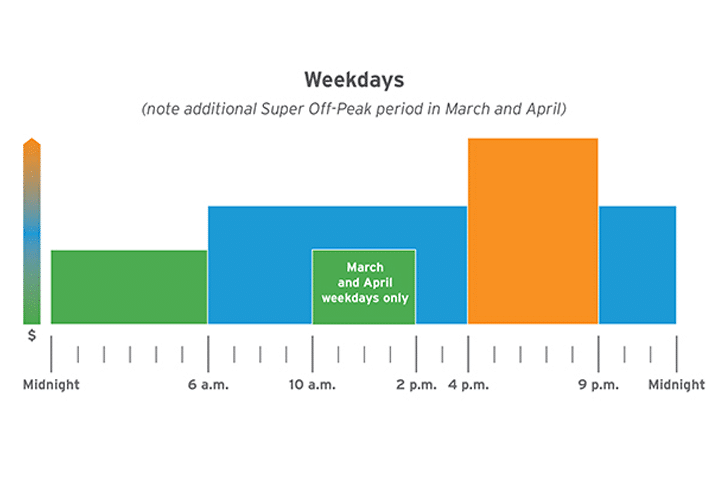Changes to utility rate periods are beginning to be implemented and can impact your bottom line. On December 1, 2017, San Diego Gas & Electric (SDG&E) became the first investor-owned utility (IOU) in the state to break tradition and with the California Public Utilities Commission’s (CPUC) blessing, shift their peak period to later in the evening. The CPUC cited its desire to keep up with a changing energy market as one of the key factors that drove this decision.
This new peak period will align better with the head of the so-called “duck curve”, a frequently referenced graph that provides a visual representation of how electricity demand changes throughout the day. The 4-9 PM peak period will now correspond with the time at which demand is highest during the day, when most people arrive home from school or work.

“Duck Curve” showing electricity demand throughout the day.
[Source: http://www.caiso.com/Documents/Flexibleresourceshelprenewables_FastFacts.pdf ]
What’s Changed?
SDG&E’s previous on-peak hours of 11:00 AM to 6:00 PM on non-holiday weekdays have now been changed to 4:00 to 9:00 PM. In addition to this development, a new “super-off-peak-period” will also emerge, where the lowest time-of-use rates will run from midnight to 6:00 AM on weekdays and midnight to 2:00 PM on weekends. All other hours will be considered off-peak.


Green indicates super off-peak periods (lowest demand, lowest price), blue indicates off-peak (lower demand, lower price), and orange indicates on-peak (highest demand, highest price).
[Source: SDG&E]
Following SDG&E’s lead, Pacific Gas & Electric (PG&E) began a limited rollout of this new peak period in April of this year to 150,000 of their residential electric customers. Should their bills increase, customers still have the option to opt out, but it’s expected that these rate changes will eventually be applied universally. Similarly in March, Southern California Edison (SCE) shifted 400,000 of its residential customers to plans that define either 4:00 to 9:00 PM or 5:00 to 8:00 PM as the new peak hours.
How Can Commercial and Industrial Customers Mitigate a Blow to Their Bottom Lines?
There are several measures that commercial and industrial facility managers can take in order to anticipate the full rollout of this policy change to all customers, and even potentially save money on their electricity bills.
Automate Peak Forecasting
There is software that will model the response of your building to weather and time-of-week, and alert you the day before you are expected to set your peak for the month (our friends at Gridium make one). Since most demand charges are set by the highest 15 minute period of the month, special attention on those days can pay substantial dividends. You can mitigate those peaks if you anticipate them through global setbacks, fan limiting, or pre-cooling to coast through demand hours.
Carefully Examine Your Peak Days – What Drives Your Peak Period?
We once had a customer who always set their monthly peak demand on Thursdays – a fact that we noticed by reviewing load profile data with interval data. Turns out that they had a new, high efficiency chiller than ran most of the time, and an old chiller that they only ran once a week (“old chiller Thursday”) to make sure it was operational and to allow time for maintenance on the newer one. Switching that to “old chiller Saturday” instead shed them about 50 kW of unnecessary peak demand charges.
Implement Temperature Setbacks During the Peak
Another strategy for reducing energy usage during the peak period is reevaluating the temperature setpoints on the thermostat. For example, from 4-9 PM we would recommend changing standard setpoints of 70 degree heating and 74 cooling to 69/75 respectively, or even 68/76.
Widening the dead-bands (the temperature range in which neither heating or cooling systems are turned on) ensures that incrementally less amounts of heating and cooling energy will be consumed, without compromising occupant comfort. These settings can be scheduled to run automatically with an energy management system (EMS).
Consider Investing in Energy Storage
Depending on customers’ current electricity and net energy metering (NEM) rates, c Since peak solar production (highest during midday to early afternoon) no longer coincides with peak demand hours, the “peak shaving” method (reducing facility energy consumption when demand on the utility is highest) will be rendered less effective.
Before pursuing this option, we highly recommend conducting a thorough cost-benefit analysis, since this measure will require an initial investment in energy storage equipment and may take some time to pay itself back. However, if found to be cost-effective, facility managers could potentially save money over time. The system would be able to store electricity generated during peak production and allow customers to use it from 4:00 to 9:00 PM, when energy prices and demand on the grid are highest.
Time to Implement
Implementing any of these strategies can help you take advantage of the upcoming rate changes instead of being blindsided by them. If you need further assistance, you can always contact your utility account representative for more information. If you’re thinking it might be time to take an in-depth look at your building to further optimize operations, we’d be happy to help. Our engineers have an extensive understanding of building systems, the changing energy policy landscape, as well as available utility incentives. If we can help you reduce your energy usage and strengthen your bottom line, please don’t hesitate to contact us anytime.


